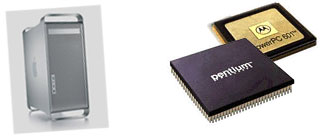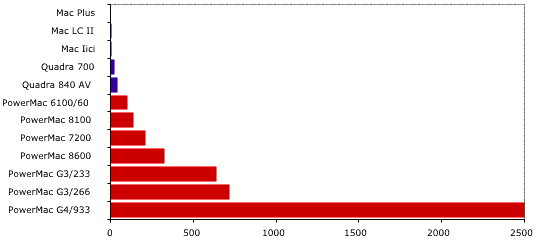
About RISC (Up to OJB's Mac Info Page) Update: Successful Intel Transition (2008)The transition to Intel processors has been complete for a while now and it seems to have been very successful. The new Intel machines are fast and reliable and their power consumption is reasonable. Developers who use Apple's development tools transitioned reasonably easily and will also be able to transition to other technologies in future OS releases (true 64 bit, the new thread despatch model, etc) easily. A useful side effect of the transition is the ability to run Windows at full speed (such as it is) as well as Mac OS X. While running Windows could be seen as eliminating the main reason for having a Mac it is a useful feature for people who really need to run one Windows program or need the security just being able to run Windows programs (even though we hope they will never have to). Update: Intel Processor Announcement in 2005Apple have announced that they will use Intel processors (the same used in current PCs) in the Macs of the future. The PowerPC processor has done a good job for many years, but IBM are encountering big problems in increasing the speed without creating issues with heat generation. This has made G5 based PowerBooks impossible. The processor used in the computer probably doesn't matter much to the end user, and although there will be a transition period while software is translated, this shouldn't case many problems to the average user. Update: Mac OS X in 2002Mac OS X makes better use of many hardware features than Mac OS 9 and before. For example multiple processors are only supported by X (although certain programs, such as PhotoShop, can specifically use the second processor with systems older than X). Mac OS X also makes better use of the AltiVec (velocity engine) in the G4 processor. Again specific programs can use the G4 efficiently in systems before Mac OS X. Of course there are many basic features of even older processors that are not utilised (or not well utilised) by older systems. For example protected memory, virtual memory and preemptive multi-tasking. There is no doubt that Mac OS X is the future of Apple, so if your computer has sufficient capacity (a G4 or faster G3 processor, a good video accelerator, 256MB or more memory) and the software you want to use is available for Mac OS X (or at least works well in the Classic environment) then you really should use Mac OS X. Update: Power Macs in 2000The G4 processor can really fly, but only if you have software to make use of it. If you are considering a G4 instead of an iMac, check that the software you plan on running knows how to use the G4 processor or you won't gain any benefit from the extra expense--the G4 is the same speed as the G3 running standard software. If you use programs like Photoshop which know about the G4 you will really notice the difference! A similar situation exists regarding multiple processors. The current Mac OS doesn't use multiple processors automatically. If the software you want to use can use extra processors or you are planning ahead for the time when Mac OS X will use them, that's fine, but don't expect any noticeable difference in most tasks now. Update: New Technologies for 1998The G3 processor has pushed the PowerPC processor significantly ahead of Pentium II again in most situations--even at slower clock speeds. IBM's copper technology and smaller manufacturing technologies such as 0.13 micron are likely to be used in PowerPC chips well before they are available from Intel. So the Mac's performance edge looks safe for the foreseeable future. PowerMac Speed InformationThe critical thing to remember when evaluating the speed of a Power Mac is that they run two types of programs: Power Mac native and emulated conventional Mac programs. Generally native programs are faster but to get the most benefit from the PowerPC architecture it is necessary to write programs a particular way--not all software developers do this really well. 
Overall performance of a collection of PowerPC based Macintosh computers and some equivalent PCs. Performance measurement is notoriously difficult and real speed depends on many factors so this graph can only be used as a general guide. To complicate matters system components which all programs use can also be either native or emulated because Apple hasn't ported all the system yet. So a fully native program can still run a lot of emulated code which will slow it down. As if that wasn't enough there are two major revisions of the emulator. The newer one, present in newer machines such as the 7200, is usually much faster than the original. How to Make Your Machine Faster - Old Machines Only!My first advice to Power Mac owners is "buy more memory". It doesn't really matter how much you have--you probably need more! In most cases 24MB will be enough but if you are running big programs like Excel, Photoshop or Freehand you should get more. I use 48MB and 32MB in my two machines which is enough for most purposes. When you get more memory turn virtual memory off. You will probably find at this stage that everything starts flying! Update 2002. Wow, things have changed since I wrote that! Modern Macs should have at least 128MB, preferably more. I run many programs on my machine with 640 MB of RAM and under Mac OS X you never run out of memory! If adding the memory didn't help you should check your software to make sure it is PowerPC native. There is usually a graphic saying "Accelerated for Power Mac" somewhere on the program's splash screen or box. If your program isn't native upgrade it--there are Power Mac versions of almost every program now. If you can't get a Power Mac version of the program try speeding up the emulator using Connectix' Speed Doubler system extension. As always be aware of the possibility of conflicts when installing a new extension. Update 2002. For best performance under Mac OS X try to find programs designed specifically for it. There doesn't seem to be much advantage in using Cocoa or Carbon programs but Java programs will probably be a bit slow. There are some programs which are just badly written and won't go much faster no matter what you do. Word 6 is probably the most obvious example. In this case you will either need to buy a faster machine, put up with the lack of speed, or use a different program that is fast (for example Word Perfect). Comparison with Conventional MacsSo how fast are Power Macs when they are set up correctly? It depends how you measure speed. Running basic benchmark test such as Norton's System Info shows a typical Power Mac (I will use my 7200/120 with 48MB of RAM and level 2 cache as an example) to be 130 times faster than a Mac Plus! In extreme cases such as some floating point maths test the Power Mac is 35,000 times faster! 
This graph shows an overall speed comparison of various current and older Power Macs compared with a selection of older conventional Macintosh computers. Comparison with Other ComputersThe RISC architecture used in the PowerPC chip which the Power Macintosh uses is generally more efficient and cheaper to produce than the conventional CISC used in the chips PCs use. Generally a PowerPC processor running at the same speed as a Pentium or Pentium Pro will significantly out-perform it. The big advantage with PowerPC is the relative ease with which really fast processors can be made in future. For example a 500 to 1000 MHz versions are being developed. The PC architecture is only surviving because Intel have the huge resources needed to keep their outdated design competitive. In most cases PowerPC based machines will run real programs faster than their competitors. This especially applies to graphics and multimedia applications where Macs have a huge lead. Of course there are some programs where things aren't quite so good--Microsoft products for example, especially Word 6 where the PC versions are actually faster. ![[Up]](../XuShared/Up2B.jpeg)
Insert query failed: INSERT INTO log VALUES (NULL,1,'2025-12-23','010450','Power.html','XuMacInfo','216.73.216.208','Mozilla/5.0 AppleWebKit/537.36 (KHTML, like Gecko; compatible; ClaudeBot/1.0; +claudebot@a','');. |